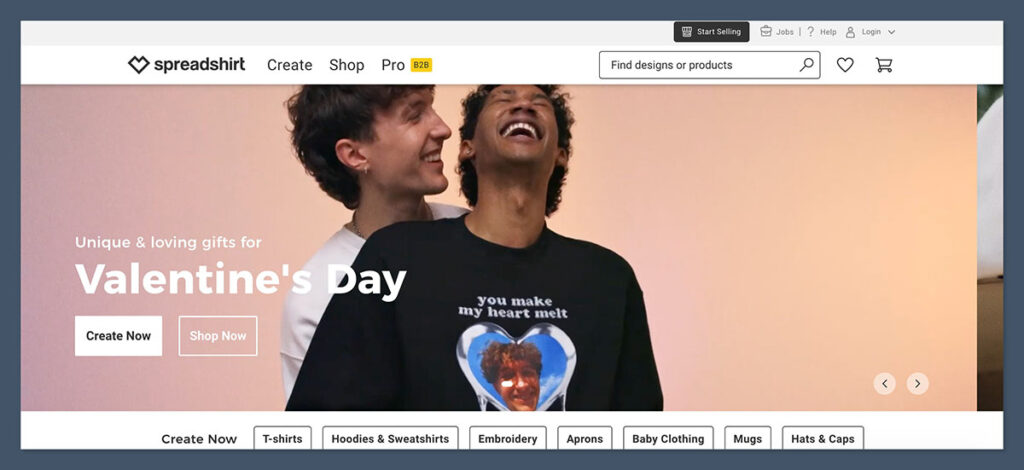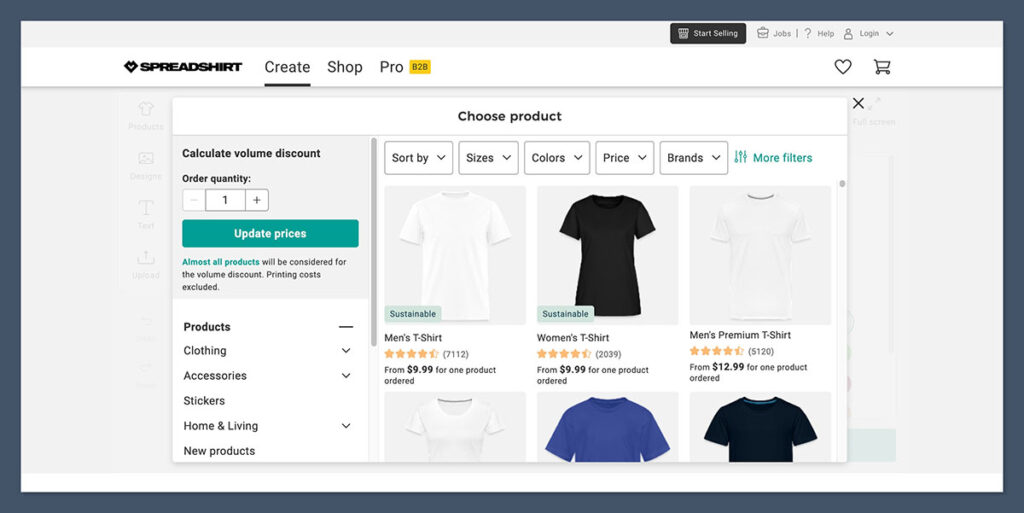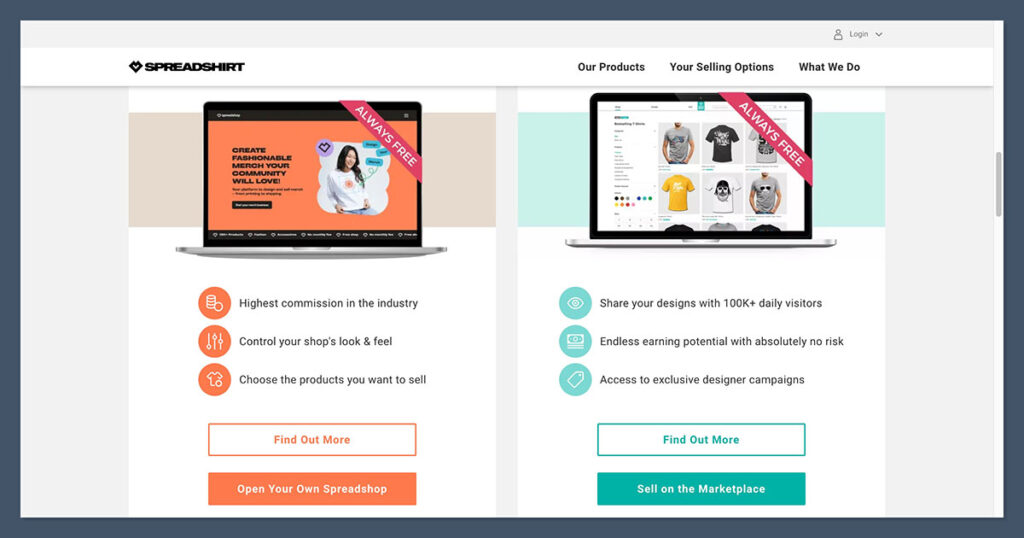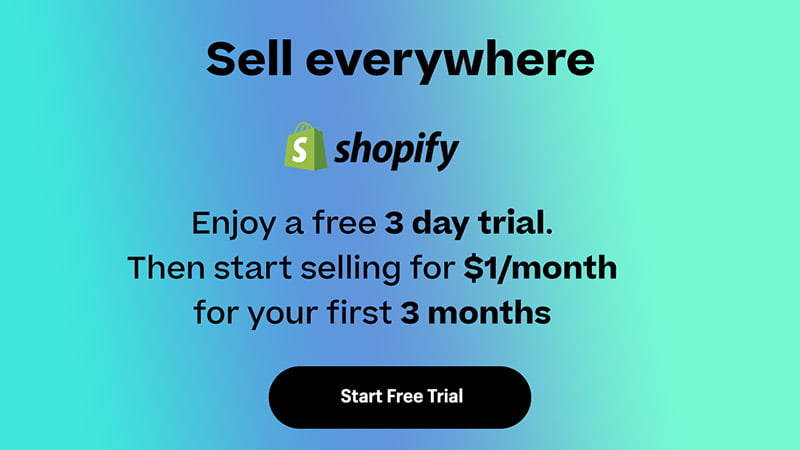Disclosure: We may earn a commission or fee from some of the links in our content. However, this does not affect our recommendations. Learn more.
Quick Answer: Spreadshirt is a solid low-risk way to start selling print-on-demand products with zero upfront investment.
But it’s not the most flexible platform, and you’ll need to put in work to stand out on its crowded marketplace. If you’re just starting and want to test designs without paying for inventory, Spreadshirt makes sense.
But if you want more control over branding and marketing, you might hit some walls fast.
Why You Can Trust This Review
I’ve been in the print-on-demand and dropshipping game for nearly a decade.
I’ve run my own stores, tested most POD platforms, and coached others building POD brands. I’ve worked with Printful, Gelato, Teespring, and more.
This review is based on actual experience using Spreadshirt to test product lines, launch new designs, and experiment with both Marketplace and Spreadshop.
No hype—just honest feedback about what it’s like to sell here.
Spreadshirt Pros & Cons
| Pros | Cons |
|---|---|
| Free to start with zero upfront cost | Customisation is limited |
| Built-in traffic from their marketplace | You don’t own your audience |
| Decent product quality and print options | Branding control is minimal |
| Supports multiple regions (US, EU) | No advanced marketing tools |
Getting Started With Spreadshirt

Signing up was easy. No credit card, no verification steps—just email, password, and I was inside.
You can either list products on their Marketplace (they drive the traffic), or set up your own Spreadshop (you do the marketing).
It’s low-risk and perfect for testing designs quickly without the usual setup headaches.
What stood out during sign-up was the minimal friction. I wasn’t asked to jump through any hoops or verify my ID.
Once logged in, I landed on a clear dashboard that immediately let me start uploading designs.
Spreadshirt doesn’t overload you with features upfront, which makes it approachable if you’ve never used a POD platform before.
My initial setup looked like this:
- Pick a username and artist profile
- Upload designs and choose which products to sell them on
- Adjust colors, positioning, and product types
- Publish your designs to the Marketplace or add them to a Spreadshop
It only took 30 minutes to get my first T-shirt live on the Marketplace. No manual approval delays, no hidden steps.
It’s one of the fastest go-to-market experiences I’ve had with any POD platform.
Things that worked well:
- Super intuitive onboarding
- Marketplace listings go live quickly
- Dashboard is clean and not overloaded with features
- You can test dozens of products with one design upload
- Great first-step platform for artists or beginners
Things that felt clunky:
- The design tool is very basic and limited in control
- No way to preview how your full storefront looks if you’re just using the Marketplace
- Limited onboarding for Spreadshop features, especially around customisation
- Not much guidance on how to actually drive traffic if you go the Spreadshop route
There’s a clear divide between the Marketplace and Spreadshop experience. Marketplace is passive—you upload, they handle traffic.
Spreadshop gives you more control, but it feels like you’re left to figure things out yourself.
If you’re familiar with tools like Shopify, the lack of walkthroughs and integrations is noticeable.
How Spreadshirt Pricing Works
One of the best parts about Spreadshirt? It’s 100 percent free to start. You don’t pay for a subscription. There are no hosting fees.
You only pay when someone buys something—so there’s zero financial risk upfront. That makes it especially attractive for new sellers who want to test ideas before going all in.
Spreadshirt uses a base cost plus markup model. The way you earn depends on whether you’re selling through the Marketplace or via your Spreadshop.
Both use the same printing backend, but the earnings structure is different.
Here’s how the money flows:
- Base product cost + printing fee = what Spreadshirt charges you
- You set your own markup (called a “design price” in Marketplace sales)
- Your earnings = markup or the profit margin you define
This model keeps things simple, but it does mean you need to understand the margins well if you plan to scale.
Example Payout Table
| Product | Base Cost | My Markup | Earnings |
|---|---|---|---|
| T-Shirt (Classic) | $13.99 | $5.00 | $5.00 |
| Hoodie | $26.99 | $7.00 | $7.00 |
| Mug | $12.49 | $4.00 | $4.00 |
With Marketplace sales, Spreadshirt sets the final retail price, and you earn a flat “design price” per sale. That usually ranges between $3 and $7, depending on the product. You don’t have to manage any of the pricing, but you also don’t control how your work is positioned or promoted.
With Spreadshop sales, it flips. You’re in control of the retail price, so you can adjust margins however you want. You still pay the same base price, but if you can drive traffic to your shop, your earning potential is much higher.
Key points to keep in mind:
- Marketplace is more passive, but margins are lower and fixed
- Spreadshop offers more flexibility, but you’ll need to handle your own promotions
- You can run both at the same time to test what works best
- Discounts, bundles, or upsells aren’t built-in—you’ll need to adjust pricing manually if you want to create incentives
Spreadshirt is one of the few POD platforms that lets you sell for free. But your profit potential is capped unless you’re using Spreadshop and driving traffic yourself.
If you’re serious about scaling, Spreadshop gives you more options—but it also demands more effort.
Uploading Designs and Creating Products

This part is fast and easy—but very limited in terms of flexibility. Spreadshirt’s design interface is built for speed, not precision.
That’s great if you’re trying to test ideas quickly, but frustrating if you’re used to more robust tools like Printful’s Product Designer or third-party mockup generators.
The process is simple:
- Upload a high-resolution PNG file (ideally 300 DPI with a transparent background)
- Select which products you want it applied to
- Adjust placement, size, and product colors
- Preview and publish
Spreadshirt automatically generates mockups for every item and pushes them live to either your Marketplace listings or Spreadshop, depending on where you’re selling.
You don’t need to worry about things like mockup templates, sizing guides, or image formatting—it’s all handled for you.
What’s good:
- Large product catalogue including:
- T-shirts (classic, premium, organic)
- Hoodies and sweatshirts
- Mugs, phone cases, hats, aprons, tote bags, and more
- Mockup generation is automatic with every listing
- One upload can be applied across dozens of products
- Color combinations and placement options are straightforward
This makes it easy to scale a single design across an entire range of items. It’s ideal for artists, illustrators, or content creators who want to launch quickly.
What’s missing:
- No branding options like neck tags, hem tags, or custom packaging
- Limited design placement—front, back, or a fixed area only
- No control over zoom, rotation, or advanced positioning
- Bulk editing is not possible—you’ll need to tweak each listing individually
- No integration with tools like Placeit, Smartmockups, or Canva for enhanced visuals
You also won’t find multi-angle mockups or lifestyle images, which can hurt your conversion rate if you’re planning to run ads or build your own shop.
Everything is fairly uniform, and while that keeps things efficient, it limits your creative control.
Marketplace vs Spreadshop – What’s the Difference?

Spreadshirt gives you two ways to sell your designs, and the one you choose will shape how your business grows. You can either publish your designs to their Marketplace, or build and manage your own branded Spreadshop. Both models have their benefits, but they serve very different types of sellers.
1. Spreadshirt Marketplace
Think of this like Redbubble or TeePublic. You upload your design, and it becomes searchable on Spreadshirt’s global platform.
They handle the traffic, customer service, fulfilment, and payments.
How it works:
- You upload designs, set a “design price,” and assign them to products
- Spreadshirt determines the retail price and takes care of listing them
- You earn a fixed amount per sale, depending on the product and design price
It’s hands-off and works well if you just want passive sales from organic traffic.
Pros:
- Spreadshirt drives traffic to your listings
- You earn passive income without managing a store
- Ideal for artists, designers, or hobbyists who just want to upload and go
- No marketing or support required from your end
Cons:
- Extremely competitive—millions of designs already live
- No control over final retail pricing
- No branding or customer loyalty building
- Sales data and reporting are basic
- No ability to retarget customers or build an email list
Best for: Testing designs, generating passive income, and low-effort selling.
2. Spreadshop
This is your own branded storefront, hosted by Spreadshirt but separate from their marketplace. You decide what products to sell, how much to charge, and what your site looks like.
How it works:
- You launch a Spreadshop with its own subdomain (or connect a custom domain)
- Upload your designs and choose product categories
- Promote your shop via social, ads, email, or SEO to drive traffic
- You keep the profit margin after base costs are deducted
It’s a more active approach but gives you more control over the business.
Pros:
- More control over retail pricing and profit margins
- You can create a branded experience with themes and logos
- Ability to add discounts and run promotions
- You’re building your own asset, not just uploading to someone else’s platform
Cons:
- You’re responsible for all the traffic and marketing
- Organic reach is minimal without promotion
- Limited design flexibility—customisation options are basic
- No advanced ecommerce features like upsells or abandoned cart emails
- Template variety is limited compared to Shopify or WooCommerce
Best for: Sellers who want to build a brand, run campaigns, and own the customer relationship.
Marketplace is great for passive side income.
Spreadshop is better if you want to start building a real brand—but it still lacks the freedom that other platforms offer.
If you’re serious about POD long-term, Spreadshop is the better pick, but you may eventually need to migrate to a more flexible platform to scale properly.
Print Quality, Fulfilment and Shipping
Spreadshirt handles production and shipping in-house, with printing facilities across multiple regions including the US and EU.
This setup allows them to deliver faster to customers while avoiding customs delays and international shipping fees.
That’s a major plus if you’re trying to serve both American and European buyers without juggling separate fulfilment partners.
Their operations are streamlined for speed and consistency. Once a customer places an order, it enters their automated production workflow and is shipped directly from the closest facility.
This reduces lead time and helps ensure consistent quality.
Turnaround Time
- Fulfilment: Most orders are printed within 2 to 4 business days
- Shipping: Delivery takes between 5 and 12 days, depending on the destination and shipping option chosen
- Tracking: Standard tracking is included, though some lower-cost methods may have limited updates
These timelines are fairly standard for POD, and in my experience, orders to US customers usually arrived within a week.
Print Methods
Spreadshirt uses three main printing techniques:
- Digital Direct (DTG): Most common method for full-color, photo-quality prints
- Flex Printing: Best for bold, single-color vector designs; durable with a slightly raised texture
- Flock Printing: Similar to flex but with a velvet-like feel; used less often
DTG is the go-to for most apparel, and the results are clean and consistent. Colors hold up well after a few washes, especially when printed on lighter garments.
Flex and flock are more niche, but they do offer variety for customers who prefer different finishes.
Product Quality
Spreadshirt uses decent-quality blanks. They’re not premium, but they’re not cheap either.
What I noticed:
- T-shirts are on par with basic Gildan or Fruit of the Loom—reliable and durable for the price
- Hoodies feel soft and substantial, especially in their “premium” range
- Mugs and tote bags came out well, with crisp designs and good color accuracy
- Stitching and materials held up well after multiple washes
You’re not getting luxury streetwear quality here, but for casual wear or fan merch, the quality holds its own.
Returns and Support
- Marketplace orders: Spreadshirt handles all customer service, returns, and refunds
- Spreadshop orders: You’re responsible for managing support, though they still handle production issues
If there’s a print defect or shipping problem, Spreadshirt typically replaces the item without hassle.
But if your customer wants a refund for sizing or preference, and you’re using a Spreadshop, it’s on you to sort that out.
Spreadshirt nails the basics on fulfilment. If you want fast shipping and reliable printing, you’re in good hands here.
Just keep in mind, if you’re running a branded shop, you’ll need to be ready to handle customer support when things go wrong.
Customisation, SEO & Marketing Features
This is where Spreadshirt starts to show its limitations—especially if your goal is to scale.
While it’s functional for launching and testing products, it lacks the deeper tools needed for brand-building or serious ecommerce.
From SEO settings to marketing automation, most of what you get is either basic or missing entirely.
It works for getting a few listings live and selling, but don’t expect the tools to grow an audience or run advanced campaigns.
Marketplace SEO
When you upload designs to the Marketplace, you can tweak the usual details:
- Product titles
- Tags (keywords)
- Product descriptions
These edits help with internal search rankings, but competition is fierce. With millions of products on the Marketplace, even a well-optimized listing can get buried fast. You’re relying heavily on luck or niche targeting to surface in search results.
There’s no support for schema markup, no analytics dashboard to track performance, and no structured way to do A/B testing or keyword tracking.
Spreadshop SEO
Spreadshop gives you a little more freedom to optimise:
- Control over meta titles and page descriptions
- URL slugs can be edited for better readability
- You can set categories, add page content, and include your logo
You can also redirect a custom domain to your Spreadshop, although it’s technically a redirect—not true domain hosting.
So while it gives the appearance of owning your shop’s address, you don’t get full domain control like you would on Shopify or WooCommerce.
What’s noticeably absent:
- Blogging tools
- Newsletter builders or native email capture
- SEO apps or plugins
- Integration with tools like Google Search Console or Semrush
Branding
This is another weak spot if you want to create a professional look and feel.
- You can upload a logo and adjust colors within your Spreadshop
- Headers, banners, and product page layouts are limited to a few templates
- No white-label options or branded packaging
- No neck tags, inside labels, or packing slips with your store name
- No built-in upselling, bundling, or cross-sell features
Branding ends at the storefront design. Once a customer buys, the unboxing experience is 100 percent Spreadshirt—not yours.
Marketing Tools
Spreadshirt includes some surface-level marketing features, but nothing that supports long-term strategy.
What’s available:
- Basic discount code creation
- Social sharing buttons on product pages
- Ability to promote via external links
What’s missing:
- Email marketing tools (Mailchimp, Klaviyo, etc.)
- Abandoned cart recovery
- Ad platform integrations (Meta Ads, Google Ads, TikTok Ads)
- Popups, banners, or exit-intent offers
- Affiliate marketing options or referral tracking
If you’re planning to run ad campaigns or grow a newsletter list, you’ll need third-party workarounds or switch platforms entirely.
Does Spreadshirt Use AI or Automation?
No. Spreadshirt doesn’t offer any AI tools. There’s no automation for product descriptions, SEO suggestions, customer segmentation, or analytics. Everything is manual—from copywriting to pricing to promotions.
If you’re used to platforms that offer AI-generated descriptions, smart upsells, or performance recommendations, Spreadshirt will feel barebones.
This is not a growth platform. It’s a starter kit.
If you’re serious about building a brand, you’ll want to migrate later to something like Printify + WooCommerce or Printful + Shopify.
Spreadshirt can help you get off the ground—but it won’t give you the tools to scale.
Support and Security
Spreadshirt keeps things fairly straightforward when it comes to support. It’s functional, but not especially hands-on.
If you’ve used platforms like Shopify or Wix, you’ll notice right away that Spreadshirt’s support system is more hands-off and slower to respond.
When I submitted a support ticket, I got a response within 48 hours. It answered my question, but it wasn’t particularly detailed or personalised.
That’s fine for simple queries like how to update a product or manage payouts, but if you run into something technical or urgent, there’s no live chat or phone support to fall back on.
Support Options
You’ve got three main options when it comes to getting help:
- Email ticketing system: Submit requests through your dashboard or help center
- Help center: Decent library of articles covering account setup, product uploads, and basic troubleshooting
- Forum for Marketplace designers: You can connect with other users, browse threads, and share experiences
There’s no real-time support channel—no live chat, no hotline, and no one-on-one account managers unless you’re working at serious volume.
For Spreadshop users, that means learning by trial and error or relying on community knowledge to fix issues.
If you’re trying to run a professional store or offer fast customer service, this gap can slow things down.
You’ll need to take full ownership of the customer experience when selling through your Spreadshop.
Security
Spreadshirt checks all the right boxes when it comes to safety. All customer transactions are SSL encrypted, so your data and your buyers’ data are protected during checkout.
- Two-factor authentication can be enabled for added login protection
- Servers are compliant with standard data security protocols
- No major security incidents or breaches reported in recent years
While there aren’t any advanced user permissions or backend logs like you’d find in more technical ecommerce platforms, the basics are well covered.
Spreadshirt vs Competitors
When comparing Spreadshirt to other major print-on-demand platforms, it’s clear that each one caters to a different type of seller.
Spreadshirt shines for low-risk, low-effort selling—but it starts to show its limits as you try to grow.
If you’re just getting started, it’s a strong contender. If you’re aiming to build a fully branded ecommerce business, it’s probably not your final stop.
Here’s how Spreadshirt stacks up against some of the most popular alternatives:
Comparison Table
| Feature | Spreadshirt | Printful | Redbubble | Teespring |
|---|---|---|---|---|
| Cost to Start | Free | Free | Free | Free |
| Product Control | Moderate | High | Low | Low |
| Branding | Low | High | None | Low |
| Marketplace Traffic | Medium | None | High | High |
| Best For | Beginners | Serious POD sellers | Artists | YouTubers |
What Makes Each Platform Stand Out
- Spreadshirt: Offers a balanced entry point. You don’t need to pay upfront or bring your own traffic if you stick to the Marketplace. Spreadshop gives you a bit more flexibility, but it’s still limited in terms of branding and tools.
- Printful: Best choice for sellers who want total control over their brand. It integrates with major platforms like Shopify and WooCommerce, offers custom packaging, and supports large-scale ecommerce operations. However, there’s no built-in marketplace, so you must generate your own traffic.
- Redbubble: Built for independent artists looking to tap into an active marketplace. There’s no branding, no shop customisation, and limited product control—but it’s extremely easy to use and your designs can reach a wide audience quickly.
- Teespring (now Spring): Tailored for creators with a built-in audience, especially YouTubers. Integration with social platforms makes it simple to sell merch directly from your content, but branding and design control remain limited.
Verdict
Use Spreadshirt if you want to dip your toes into POD without spending a dollar. It’s perfect for beginners testing their first designs or looking to earn some passive side income.
But if you’re serious about building a brand and scaling long-term, Printful or Printify + WooCommerce offer more robust tools, flexibility, and growth potential.
Spreadshirt is a strong launchpad—but not the best home base for growing a full-scale POD business.
Final Verdict: Should You Use Spreadshirt?
If you’re looking for a low-commitment way to get started in print-on-demand, Spreadshirt is a solid choice.
It removes a lot of the friction that newer sellers face—no upfront costs, no tech setup, and a built-in audience through its Marketplace.
That makes it one of the easiest platforms to launch your first few products and test if your designs actually sell.
But the simplicity comes at a cost. As soon as you want more control—over pricing, branding, or customer experience—you’ll start to feel boxed in.
There are no advanced tools, limited design flexibility, and almost no room to build a fully custom storefront.
Spreadshirt gets you going, but it won’t carry you very far if your goal is to run a serious ecommerce brand.
Yes, use Spreadshirt if:
- You’re a beginner and want to test your designs quickly
- You don’t want to spend money upfront on a platform or tools
- You’re happy letting Spreadshirt manage the production, fulfilment, and customer service
- You just want to earn some side income through passive Marketplace sales
No, avoid Spreadshirt if:
- You want full control over branding, packaging, or customer data
- You need integrations with marketing tools, ad platforms, or analytics
- You’re planning to run a full ecommerce store with upsells, email campaigns, and repeat customers
- You want to build a recognisable brand or scale beyond a small shop
My Takeaway
Spreadshirt is an easy way to get started in print-on-demand—but it’s not where you’ll finish.
Think of it as a launchpad. You can test designs, understand what sells, and learn the ropes without spending a dime.
But once you start to see real traction, you’ll want to move to a platform that gives you more control over your business, your brand, and your customer relationships.

